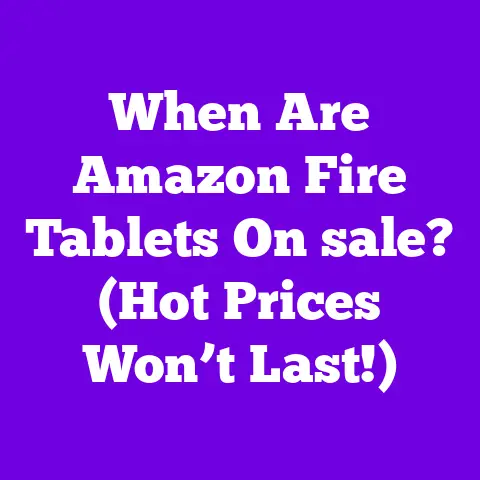When Do New Year’s Sales Start? (Don’t Miss These Deals!)
As the confetti settles and the clock strikes midnight, I find myself wondering: when do the best deals of the New Year actually begin?
The New Year is not only a time for resolutions and fresh starts; it’s also a prime opportunity for savvy shoppers to snag incredible discounts.
With the holiday season behind us, retailers are eager to clear out inventory and entice consumers with enticing promotions.
In this article, I delve into the timing of New Year’s sales, the types of deals available, the psychology behind shopping during this period, and much more.
Let’s embark on this journey to make the most out of the New Year’s sales!
Overview of New Year’s Sales
What Are New Year’s Sales?
New Year’s sales are a series of promotional events that kick off shortly after the holiday season, often starting just after Christmas and continuing into early January.
These sales are significant in the retail calendar as they mark the transition from the holiday shopping frenzy to a more subdued buying period.
Retailers often use this time to clear out excess inventory, making way for new products in the upcoming spring season.
The Evolution of New Year’s Sales
Over the years, New Year’s sales have evolved dramatically.
Traditionally, these sales were viewed as a way to move leftover holiday stock.
However, with the rise of e-commerce and changing consumer behaviors, retailers have adapted their strategies.
In the past, shoppers might have flocked to brick-and-mortar stores on New Year’s Day, but now, many prefer to browse deals from the comfort of their homes.
Moreover, economic factors play a significant role in shaping New Year’s sales.
Following the 2008 financial crisis, many retailers began implementing deeper discounts to stimulate consumer spending.
Similarly, the COVID-19 pandemic has prompted many businesses to shift focus to online sales and contactless shopping options, changing the landscape of New Year’s deals.
Timing of New Year’s Sales
When Do New Year’s Sales Typically Start?
New Year’s sales typically begin immediately after Christmas and last through the first week of January.
Most retailers kick off their promotions on December 26, with some extending their discounts into mid-January.
Here’s a general timeline:
-
December 26: The day after Christmas, many retailers start their New Year’s sales, offering discounts on holiday merchandise, clothing, and more.
-
December 31 – January 1: Some retailers may have limited-time deals on New Year’s Eve or Day, often focusing on items like party supplies or festive clothing.
-
January 2 – January 15: As the New Year progresses, sales often continue, featuring deeper discounts as retailers aim to clear out winter inventory.
Major Retailers and Their Strategies
Let’s take a closer look at how some major retailers approach New Year’s sales:
Amazon: Known for its aggressive pricing strategies, Amazon often starts its New Year’s sales on December 26.
Shoppers can find discounts on a wide range of products, from electronics to home goods.Walmart: Walmart typically offers post-Christmas clearance sales starting on December 26.
Their promotions often include significant markdowns on seasonal items, clothing, and household goods.Macy’s: Macy’s is famous for its New Year’s sales, which often start around December 26 and extend into January.
They focus on apparel, home goods, and beauty products with eye-catching discounts.
Factors Influencing Sale Dates
Several factors influence when retailers launch their New Year’s sales:
Inventory Clearance: After the holiday rush, retailers are eager to clear out leftover stock.
This urgency drives the timing of their sales.Consumer Demand: Retailers closely monitor consumer behavior and trends.
If certain products are in high demand, retailers may stagger their sales to maximize profits.Competition: With many retailers vying for consumer attention, competition also plays a role.
Retailers often adjust their sale strategies to either align with or differentiate from competitors.
Types of Deals Available
Commonly Discounted Products
During New Year’s sales, I’ve noticed that certain categories of products are frequently discounted.
Here’s a breakdown:
Clothing: Retailers often reduce prices on winter apparel to make way for spring collections.
This includes coats, sweaters, and holiday-themed clothing.Electronics: New Year’s sales can be a great time to find deals on electronics.
Items such as televisions, laptops, and smartphones are often discounted as retailers attempt to clear out old inventory.Home Goods: This category sees significant markdowns, especially items like kitchen appliances, bedding, and decor.
Many consumers take advantage of these sales to refresh their living spaces.
Trends in Specific Categories
Each year, I observe trends that influence which products are discounted.
For example, in recent years, there has been a notable uptick in discounts on smart home devices and eco-friendly products.
As consumers become more environmentally conscious, retailers are responding by offering better deals on sustainable options.
Popular Items on Sale
Some items consistently appear on sale during New Year’s promotions.
Here are a few popular products I recommend keeping an eye on:
-
Fitness Equipment: With many people making fitness-related resolutions, retailers often discount exercise equipment, gym memberships, and fitness apparel.
-
Kitchen Appliances: As folks look to cook more at home, small kitchen appliances like air fryers and instant pots frequently see markdowns.
-
Beauty Products: The New Year is often a time for fresh starts, and many beauty retailers capitalize on this by offering discounts on skincare and makeup products.
The Psychology of Shopping During New Year’s Sales
Fresh Starts and New Resolutions
The New Year is synonymous with fresh starts and new resolutions, and this psychological aspect significantly drives consumer behavior.
Many of us, myself included, see the New Year as an opportunity to set goals and make positive changes.
This mindset often translates into a desire to purchase items that align with those resolutions, whether it’s fitness gear, organizational tools, or home improvement supplies.
Emotional Triggers Used by Retailers
Retailers are keenly aware of these psychological triggers and often use them to their advantage.
Here are a few tactics they employ:
Limited-Time Offers: By creating a sense of urgency, retailers encourage consumers to act quickly.
Phrases like “limited time only” or “while supplies last” can spur impulse buying.-
Exclusive Discounts: Retailers may offer special deals to loyal customers or newsletter subscribers, fostering a sense of belonging and encouraging spending.
-
Positive Messaging: Marketing campaigns often focus on themes of renewal and self-improvement, appealing to shoppers’ desires to enhance their lives.
Online vs. In-Store Shopping
Advantages of Shopping Online
As someone who enjoys the convenience of online shopping, I appreciate the benefits it offers during New Year’s sales:
-
Convenience: Shoppers can browse deals from the comfort of their homes without the hassle of crowds.
-
Price Comparison: Online shopping allows for easy price comparisons across different retailers, helping consumers find the best deals.
-
Wider Selection: E-commerce often provides a broader range of products than what is available in-store.
Disadvantages of Online Shopping
However, online shopping does have its downsides:
-
Shipping Costs: Some retailers charge for shipping, which can negate the savings from discounts.
-
Delayed Gratification: Unlike in-store shopping, where you can take home your purchases immediately, online shoppers often have to wait for delivery.
Advantages of In-Store Shopping
On the other hand, in-store shopping offers its own set of benefits:
-
Immediate Access: Shoppers can take items home right away, which is particularly appealing for urgent needs.
-
Tactile Experience: Being able to see, touch, and try on products can enhance the shopping experience, especially for clothing and home goods.
Disadvantages of In-Store Shopping
Yet, in-store shopping also has drawbacks:
-
Crowds and Long Lines: The excitement of sales can lead to busy stores, which may deter some shoppers.
-
Limited Stock: Physical stores may run out of popular items faster than online retailers.
E-Commerce Trends During New Year’s Sales
According to recent statistics, online shopping has surged during New Year’s sales.
A report from the National Retail Federation indicated that more than 60% of consumers planned to shop online for New Year’s deals in 2023.
This trend highlights the growing preference for e-commerce, as consumers appreciate the ability to browse and compare products without leaving home.
Tips for Maximizing Savings
Practical Tips for Shoppers
To make the most of New Year’s sales, I’ve compiled some practical tips that can help you find the best deals:
Set a Budget: Before diving into sales, determine how much you can afford to spend.
This helps prevent overspending and encourages more thoughtful purchases.Create a Shopping List: Write down what you need or want to buy.
This helps keep you focused and prevents impulse buys.Sign Up for Newsletters: Many retailers offer exclusive discounts to newsletter subscribers.
Sign up to receive alerts on sales and promotions.-
Use Price Comparison Tools: Websites and apps that allow you to compare prices across different retailers can help you ensure you’re getting the best deal.
Follow Brands on Social Media: Retailers often announce flash sales and exclusive discounts on their social media platforms.
Following them can give you a leg up on deals.-
Be Patient: If you can wait, consider holding off on certain purchases until later in January when discounts may deepen.
-
Check Return Policies: Before making a purchase, familiarize yourself with the retailer’s return policy, especially for items that may not meet your expectations.
Future Trends in New Year’s Sales
Speculating on the Evolution of New Year’s Sales
As we look to the future, I can’t help but wonder how New Year’s sales will evolve.
Several trends are already emerging that may shape the landscape in the coming years:
-
Technological Advancements: With the rise of augmented reality (AR) and virtual reality (VR), retailers may offer immersive shopping experiences that allow consumers to visualize products in their homes before purchasing.
Sustainability Trends: As consumers become increasingly conscious of their environmental impact, retailers may prioritize sustainable products and eco-friendly practices.
This could lead to more promotions on green products during New Year’s sales.-
Personalized Shopping Experiences: The use of artificial intelligence (AI) to analyze shopping behaviors may allow retailers to offer personalized deals tailored to individual preferences.
Expert Opinions and Forecasts
Industry analysts predict that the shift toward e-commerce will continue in the coming years, with New Year’s sales becoming more digital-centric.
According to a report from eMarketer, online retail sales are expected to account for over 30% of total retail sales by 2025.
This shift will likely lead retailers to invest more in their online platforms, creating a more seamless shopping experience during New Year’s sales.
Conclusion
As I reflect on the significance of New Year’s sales, it becomes clear that being aware of these promotional events can lead to substantial savings.
The combination of post-holiday clearance, evolving consumer behaviors, and strategic marketing creates a unique shopping landscape that savvy shoppers should take advantage of.
So, mark your calendars and prepare for the shopping opportunities ahead!
The New Year is not just a time for resolutions; it’s also a chance to score fantastic deals.
Remember, as the clock strikes midnight, the best deals of the New Year begin to roll in.
Happy shopping!






